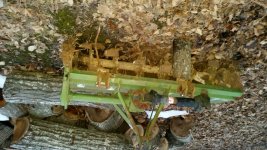TMGT
Elite Member
Hello everyone, looking for some input on replacment tines for a tiller, I've done some research on it and still haven't made up my mind so figured I would get experienced advise.
I bought a used JD 660 (built by Howard) a couple months ago and it could use some new tines, the PO replaced a few but they are outnumbered by the worn and broken ones.
The tiller currently has "L" tines on it, however after reading it looks like "C" tines might be better for my application because of rocks and clay around here.
I don't plan on doing a lot of new gardens other then a few select friends/family but I also will use it to prep for new lawns at times.
My biggest hold back on switching is that the "C" tines may not till as well on in the established gardens or give as fine a seed bed when doing shallow cuts on lawns. My worry with the "L" tines is I'll be breaking them due to rocks.
Price is the same for either style.
I might be over thinking it, but just want to optimize my equipment if I'm spending the money.
I believe the broken tines might have been due to the fact that the slip clutch was rusted solid, ended up replacing the driveshaft.
Thanks for looking.

I bought a used JD 660 (built by Howard) a couple months ago and it could use some new tines, the PO replaced a few but they are outnumbered by the worn and broken ones.
The tiller currently has "L" tines on it, however after reading it looks like "C" tines might be better for my application because of rocks and clay around here.
I don't plan on doing a lot of new gardens other then a few select friends/family but I also will use it to prep for new lawns at times.
My biggest hold back on switching is that the "C" tines may not till as well on in the established gardens or give as fine a seed bed when doing shallow cuts on lawns. My worry with the "L" tines is I'll be breaking them due to rocks.
Price is the same for either style.
I might be over thinking it, but just want to optimize my equipment if I'm spending the money.
I believe the broken tines might have been due to the fact that the slip clutch was rusted solid, ended up replacing the driveshaft.
Thanks for looking.

